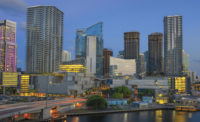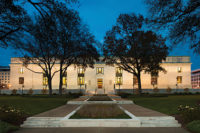Nathan Gover has a front-row seat to watch his baby grow.
Gover, a 24-year industry veteran and HVAC technician with Salt Lake City-based contracting firm CCI Mechanical, is onsite every day at City Creek Center — a mixed-use facility in Utah’s capital city. Gover was there when the first piece of equipment went online and has made it his team’s mission to enhance the system from that day going forward.
City Creek Center is an open-air shopping center that sprawls over nearly 800,000 sq. ft. (20 acres) and opened in 2010 as part of an estimated $5 billion sustainable design project geared to reinvigorate the downtown region. The final price tag of City Creek ranges from $1.5 to $1.7 billion.
“I have been here for five-and-a-half years,” Gover says. “It is one sweet system. I love operating it. We have it saddled and it runs like a top.”
Setting the foundation
City Creek Center’s plumbing and mechanical systems were designed by a team of consulting engineers from Irvine, Calif.-based firm Glumac. The company worked alongside the structural engineers with Seattle-based firm Magnusson Klemencic Associates (MKA) to provide the right system for City Creek Center.
The design process, included plenty of discussions over many months, but once a unique solution was found, the Glumac team was ready to sink its teeth into the City Creek design.
“MKA came up with a concept of a retractable roof and end walls,” says Steve Straus, Glumac’s president and CEO.
This retractable roof with end walls allowed for Glumac’s engineers to design the mechanical systems around the expectation that the center’s retail areas would remain open for the majority of the year. Therefore, there would not be a call for heating or cooling most of the time.
“We now see that energy consumption is reduced by 25 to 50% when compared to conventional, closed structures,” Straus notes. “Other success indicators are revenues generated by the stores within the malls – and business is very good.”
The City Creek Center retail areas were given LEED Gold status by the United States Green Building Council as part of the LEED for Neighborhood Development rating system. It also was a “gold” level recipient of the 2013 International Council of Shopping Centers Design & Development Award for both the “new development” and “sustainable design” categories.
Working it out
When City Creek Center first fired up, Gover states the heating system checked in at 89% efficient after the first year. Today, with the enhancements and tweaks that Gover and his CCI colleague assigned to the facility, the system runs at 92% efficient. “When you have 90 million Btu coming out of this boiler plant, 3% is huge,” he says.
Gover states that managing the aforementioned boiler plant is the most challenging aspect of ensuring the City Creek Center system is running optimally. There are 30 AERCO boilers installed that feed into one piping system. Recently, Gover was able to use the original AERCO Boiler Manager System2 and slow the staging rate of the boilers to more evenly match the secondary flow in the system.
Now, the secondary loop has a varying flow between 80 and 2,800 gpm, while the primary loop has 30 boilers at a set gpm of 150 each.
“When we started staging boilers it became apparent we were overshooting our flow on the secondary loop – sometimes by as many as three times as much,” Gover states. “We were returning a lot of that hot water back to the plant without even running it through the system. That was dropping our efficiencies.”
The primary loop had a 4° Delta-T with 15-20 boilers running, while the secondary loop had a 20-30° Delta-T, but only moved 500-600 gpm. “Our flows were mismatched,” Gover says.
Additionally, Gover set up a control system at City Creek on a reset schedule that regulates the water temperature based on when the outside air temperature ranges from -10° to 45° F.
“The warmer it is outside, the cooler the water is that is supplied to the facility,” Gover says. “The water temperature ranges from 120° to 165°.”
Gover says the reset schedule was a critical addition made to improve the efficiencies of the boiler plant. Since colder water is returned to the boilers, they have a lower flue temperature and the City Creek team can extract more heat out of the flue gas.
Melting away
The reset schedule also is used in the major snow-melt system designed for City Creek. The facility utilizes more than 170,000 sq. ft. of snow-melt surface over the two city blocks with 5/8” Watts Radiant PEX+ tubing buried below. There is nearly 315,000 lineal ft. of PEX+ tubing circulating fluids with the 52 indoor and outdoor radiant heating and cooling zones. Additionally, there are 38 tekmar 090 snow and ice sensors installed on the grounds of City Creek ready to alert the system when precipitation hits.
“We programed the building automation system that if more than 12 of those 38 sensors are wet and it is below 35°, then we override the reset schedule,” Gover says.
“Then the automation system sends a signal to the boilers saying it is -2° outside. That gets the water temperature up to 155°. This way we can have a surplus of hot water available to melt the snow. That also brings the boilers up to speed quicker.”
For the snow-melt system — as well as the indoor radiant system for the City Creek stores — there are 34 Taco KV vertical inline direct-couple pumps rated at 130 gpm and six TC 40 hp, 480-gpm vertical split-case pumps to move Btu about the developed space.
In 2015, Gover says there were several snow events with at least two of more than 6 in. of accumulation after a couple of milder seasons in the previous years.
“It was finally a typical Utah winter,” he says.
Gover states he and his team decided to scale back the snow-melt system over the past couple of winter seasons. The original system called for the snow-melt application to run at full capacity if the temperature was below 36° outside.
“We were wasting a lot of energy on days when it was not snowing,” he states. “We put some programming in during the second year to stage that snow-melt system based off the moisture sensed by the pucks and the ambient temperature.”
Making the loop
The facility’s condensing water loop is the largest loop at the City Creek Center grounds. Gover notes close to 55,000 gal. of water originates from a central plant and covers the two city blocks of the complex.
Five Taco “TA” horizontal split-case 60 hp pumps rated a 2,026 gpm at 75 head per-ft. serve the fluid coolers and water-source heat pump system. Then there are five more TAs (sized at 25 hp and 840 gpm at 75 head per-ft.) and four “FI” base-mounted end-suction pumps (rated at 125 hp and 2,375 gpm at 130 head per-ft.) that serve the condenser water loop.
The heat created is transferred five different times through four different mediums before it is rejected outdoors. Gover notes the system is designed so each store has a water-source heat pump. The heat in the air of the stores is moved via fans across evaporative coils in the water-source heat pumps and heat is absorbed into the refrigerant. Through the refrigeration cycle, that heat is transferred into the condenser water via a tube-in-tube heat exchanger.
Next, the heat is moved into the water that gets circulated up to the central plant where it is moved through a plate-frame heat exchanger. Then the heat is transferred from the water to a 40% glycol solution.
The glycol solution is pumped through tube bundles inside closed-circuit cooling towers. There are five Evapco towers and each tube bundle is about 1,000 gal. Each bundle removes about 714 tons of heat. Inside those towers there are pumps that push the water from the sump up to the top of the tower and distribute it through PVC media. The water then drops down on top of the tube bundles. The heat in the glycol is absorbed into the water in the tower.
The warm water in the tower is picked up by the pump, goes back to the top of the tower once more where there are fans moving air in a counter-flow direction across the PVC media. Through the adiabatic process, some water is evaporated and cools down the rest of the water until the heat is finally transferred outside.
“It is quite an awesome feat and works very well,” Gover says. “One of the advantages of this system is there are areas of the facility that need heat from time to time. And there are areas that need cooling sometimes. The water is 79 to 81° year-round through this loop.
“So the pumps in the stores will take that heat out of the water and transfer that into the stores for heating. At the same time, other stores that need cooling will take the heat from the air and absorb it into the water. Then the heat just moves around into the water loop and transfers basically from store to store.”
Protecting the grounds
At City Creek, there are five Watts backflow assemblies that protect the domestic water supplies in the main mechanical areas. There are three, 3-in. 909 reduced-pressure principle assemblies, one each to serve makeup water for the cooling towers, the glycol side of the water-source heat pump condenser loop and another connected to the makeup water for the water-source heat pumps.
Additionally, there are two, 2-in. 909 reduced-pressure principle assemblies. One serves the makeup water for the boilers and the other is connected to the makeup water for the chillers.
“There are periods where we are not running the boiler plant to heat water and we are not running the cooling towers to cool the water,” Gover says. “The system is neutral; it is very efficient that way.”
Gover has a list with the more than 500 pieces of equipment installed at the City Creek Center complex. He and his partner start at one end of the facility and check each piece of equipment. That takes three months – and then they start over again.
Each time Gover does his rounds he is reminded how impressive and involved the system truly is from design to installation, and he will not stop trying to find ways to improve upon it.
“The engineering is there and sound,” he says. “It is a great facility. I am glad to be out here and running it. We really nailed it.”
This article was originally titled “Fine tuning” in the May 2016 print edition of PM Engine








